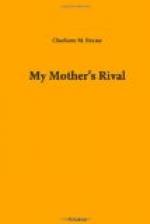My Name is Laura Tayne, and my home Tayne Abbey, in the grand old County of Kent. The Taynes were of good family, not very ancient—the baronetcy is quite a modern one, dating from George the First—but Tayne Abbey is one of the grandest old buildings in England. Whenever I looked at it I thought of those beautiful, picturesque, haunted houses that one sees in Christmas annuals, with Christmas lights shining from the great windows. I am sorry to say that I know very little of architecture. I could not describe Tayne Abbey; it was a dark, picturesque, massive building; the tall towers were covered with ivy, the large windows were wreathed with flowers of every hue. In some parts of sweet, sunny Kent the flowers grow as though they were in a huge hothouse; they did so at Tayne Abbey, for the front stood to the west, and there were years when it seemed to be nothing but summer.
The great oriel windows—the deep bay windows, large as small rooms—the carved oaken panels, the finely painted ceilings, the broad corridors, the beautiful suites of rooms—all so bright, light and lofty—the old-fashioned porch and the entrance hall, the grand sweep of terraces one after another, the gardens, the grounds, the park, were all perfection in their way. To make the picture quite complete, close to us—joined, indeed, by a subterranean passage, for the existence of which no one could account—stood the ruins of what had once been the real Abbey of Tayne—a fine old abbey that, in the time of “bluff King Hal,” had been inhabited by the monks of St. Benedict. They were driven away, and the abbey and lands were given to the family of De Montford. The De Montfords did not prosper; after some generations the abbey fell into ruins, and then they sold the abbey to the Taynes, who had long wished for it on account of the similarity of names. Our ancestors built the present mansion called Tayne Abbey; each succeeding Tayne had done something to beautify it—one had built the magnificent picture gallery, and had made a magnificent collection of pictures, so magnificent, indeed, as to rob the Taynes for many years afterward of some part of their revenue. There they stood still, a fortune in themselves. Another Tayne had devoted himself to collecting gold and silver plate; in no other house in England was there such a collection of valuable plate as in ours. A third Tayne had thought of nothing but his gardens, devoting his time, thoughts and money to them until they were wonderful to behold. There were no square and round beds of different flowers, arranged with mathematical precision; the white lilies stood in great white sheaves, the eucharis lilies grew tall and stately, the grand arum lily reared its deep chalice, the lovely lily of the valley shot its white bells; there were every variety of carnation, of sweet williams, of sweet peas, of the old-fashioned southernwood and pansy; there grew crocus, snowdrop and daffadowndilly; great lilac trees, and the white auricula were there in abundance; there, too, stood a sun-dial and a fine fountain. It was a garden to please a poet and a painter; but I have to tell the story of the lives of human beings, and not of flowers.




